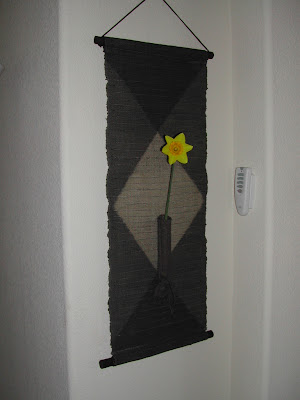We thought the Y2K bug was history. Who'd thunk that Phileas Fogg's dilemma was still relevant.

Wednesday, February 28, 2007
Some bugs can't fly
Sunday, February 25, 2007
Water Feature Side Effect
When we get a bit of rain the low spots in the property become self evident from the poorly percolating soil resulting in puddles that last for days.
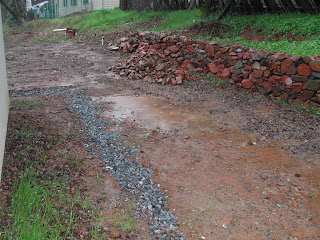 You can see were Dave put a drain from the downspout outside the office. Clearly more needs to be done to allow the water to move into it.
You can see were Dave put a drain from the downspout outside the office. Clearly more needs to be done to allow the water to move into it.


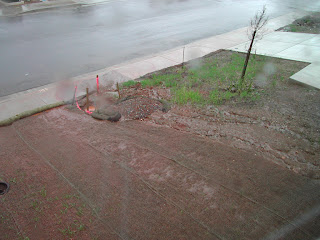
Saturday, February 24, 2007
Quilt Show
- I was impressed with The Pincushion from Davis, very nice sets of fabric. I'll go there to select fabric for one of my new projects. It was their fabric of the month program called Sweet Treat®, bundles of coordinated fabric tied up in a satin ribbon, that caught my eye.
- Patchmaker Barb (Michels) had some nice large print fabric kits that would be good for developing your free hand machine quilting technique. Since the "picture" is printed on the fabric the art/time involves quilting the image. Barb is from Magalia way out from Chico, 530-873-2238. I would like to do what she calls the Napa Harvest (green) quilt/hanging some day. The African Safari would make a great bed cover for a kids room.
 Of all the books there on quilting there was only one that I considered picking up, Sashiko, by Mary Parker (2002). I really don't have time for a new hobby right now but this is probably the direction my quilting may take.
Of all the books there on quilting there was only one that I considered picking up, Sashiko, by Mary Parker (2002). I really don't have time for a new hobby right now but this is probably the direction my quilting may take.- The local shop was the first booth that caught my attention, Cabin Fever Quilt Shoppe. The booth displayed some Japanese fabric so I thought that perhaps they have some experience with the pine bark pattern that I am not working on currently. Evidently both Patty and Cathy have made these quilts and should be able to help me learn how best to assemble the pieces.
Thursday, February 22, 2007
Tomato Sauce
| |||||||||||||||||||
Preparation
| |||||||||||||||||||
Spaghetti Westerns with Stuffed Meatballs
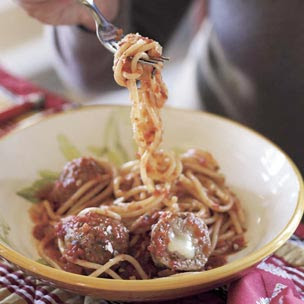
The plan is to develop a new recipe (stuffed meatballs), watch some fun foreign films while Sharon is away. I other words, be a single guy.
The meatball recipe is from Jackie and John off the Williams-Sonoma website. The tomato sauce is the one I love from ATK. The films are from Italy.
For the meatballs I'll use my tomato sauce recipe and maybe even make some garlic bread.
The process began on Tuesday when I selected the theme for my lonely weekend, Spaghetti Westerns. I planed the menu at work and started real preparation Tuesday night by watching the first side (laser disk) of Sergio Leone's Once Upon A Time In The West (1968). Henry Fonda plays the villain against Charles Bronson's harmonica playing "man with no name".
Henry Fonda plays the villain against Charles Bronson's harmonica playing "man with no name".
Friday after shopping and work we'll start off with a great salad and They Call Me Trinity . On a good day this film is humorous on a bad day silly if not stupid. I like to think of this kind of low budget quick production as a "bargain matinee" and just enjoy it for what it is without being critical. It's a film I would recommend to someone who has already seen the Sergio Leone westerns and doesn't mind wasting an afternoon on a marginally entertaining/juvenile matinee.
. On a good day this film is humorous on a bad day silly if not stupid. I like to think of this kind of low budget quick production as a "bargain matinee" and just enjoy it for what it is without being critical. It's a film I would recommend to someone who has already seen the Sergio Leone westerns and doesn't mind wasting an afternoon on a marginally entertaining/juvenile matinee.
Saturday I'll continue with another Trinity film, My Name Is Nobody (1974), also staring Henry Fonda (his last western).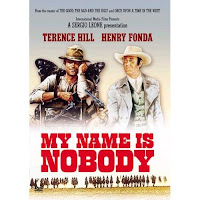 MNIN is a continuation of the Trinity character played by the same actor, Terrance Hill. (The writeups I read about the Trinity films refer to Terence Hill as though he is well known but I don't know anything about him; is he Italian, has he done anything else, was there celluloid after Trinity?)
MNIN is a continuation of the Trinity character played by the same actor, Terrance Hill. (The writeups I read about the Trinity films refer to Terence Hill as though he is well known but I don't know anything about him; is he Italian, has he done anything else, was there celluloid after Trinity?)
![]()
Stuffed Meatballs
Ingredients
1/3 cup milk1 cup fresh bread crumbs
1 lb. ground pork
1 lb. ground veal
1 lb. ground beef
1/3 cup minced fresh flat-leaf parsley, plus more for garnish
3 eggs, lightly beaten
3 garlic cloves, minced
1 3/4 tsp. kosher salt
1/2 tsp. freshly ground pepper
1/3 lb. mozzarella or provolone cheese, cut into 1/2-inch cubes
Olive oil for frying
About 6 cups tomato sauce
2 lb. spaghetti, cooked and drained
Grated Parmigiano-Reggiano cheese for serving
Preparation
- In a large bowl, combine the milk and bread crumbs. Add the ground pork, veal, beef, the 1/3 cup parsley, the eggs, garlic, salt and pepper. Mix briefly with your hands. Form the mixture into 2-inch balls. Press a mozzarella cheese cube into the center of each ball, sealing it inside.
- In a large electric skillet set on medium-high heat, heat 1/2 inch of oil until almost smoking. Add the meatballs and cook until browned, about 1 minute per side. Transfer to a paper towel-lined tray.
- Discard the oil in the pan. Pour the tomato sauce into the pan and bring to a simmer over medium-high heat. Add the meatballs, reduce the heat to medium-low, cover and simmer until cooked through, about 30 minutes. Uncover and cook for 10 minutes more.
- Put the pasta in a warmed large, shallow bowl. Top with the sauce and meatballs and garnish with parsley. Serve immediately and pass the Parmigiano-Reggiano cheese at the table. Serves 10 to 12.

The finished product. Serve with some garlic bread to sop up the wonderful sauce.
Post Script
Recipes are often used a guides as opposed to formula and today I had to make some modifications to what is suggested above.- Instead of 14 oz cans of tomatoes I used 28 oz cans
- 9 gloves of garlic in the sauce
- 3/4 teaspoon of red peppers in the sauce
- only 1 bunch of basil, should of had 2 for this much
- didn't have fresh parsley on my shopping list so couldn't use it
- 2 tablespoons of kosher salt, this may have been a pinch to much
- 4 eggs
- unable to get veal so the meat was 2.64 lbs beef/pork 2:1 with 1 lb lamb
- meatballs had 4 gloves of garlic
Monday, February 19, 2007
Auburn Radio
Here are the stations that Janet recommended. We haven't had the time to turn them in yet so instead of holding onto this scrap of paper I'm blogging it :)
These radio stations may be best heard via the internet. Please turn off you pop-up blocker.
Expand Your Mind
Introducing the Book, a YouTube short worth watching (02:25). The more things change the more they remain the same.
Sunday, February 18, 2007
Frank Film 2007
It reminds me of Frank Film, 1973 Oscar winner, a stop motion short done back in the 70s. We saw it in film school, SFSU, and I believe it even aired on The Smothers Brothers Show.
Hammer & Coop
 Hammer & Coop is web entertainment for the YouTube generation.
Hammer & Coop is web entertainment for the YouTube generation.
The opening shot in the title sequence is an homage to Buckaroo Banzai's jet car.
Funky 70's eclectic boggy from my high school days.
I expect that after the first season is completed there will be a DVD release similar to BMW Films The Hire. This fine set of short films are a stunning example of advertising as entertainment with product placement enriching the impact of cinema. If you haven't seen The Hire short films then you will just have to come over and watch them on my big screen TV.
Click on this sensual screen background image. I love the twinkle in Coop Zero 7's eye ;).

Saturday, February 17, 2007
Oak Tree―Woodland Habitat
 The are twenty species (30 varieties) of oak in California ranging from the coast through the central valley and into the Sierra Nevada. The Indians used the acorn as a primary food source and the white man used its wood for building and fire. It wasn't until recently that the oak as been valued/recognized for their ecological, economic, scientific, and aesthetic value. Like the rocks in the great Sierra Nevada Range these noble trees were taken for grant by the immigrants; perhaps because they are so plentiful or because there are similar to the trees of their native lands.
The are twenty species (30 varieties) of oak in California ranging from the coast through the central valley and into the Sierra Nevada. The Indians used the acorn as a primary food source and the white man used its wood for building and fire. It wasn't until recently that the oak as been valued/recognized for their ecological, economic, scientific, and aesthetic value. Like the rocks in the great Sierra Nevada Range these noble trees were taken for grant by the immigrants; perhaps because they are so plentiful or because there are similar to the trees of their native lands.
The library has a nice book called Oaks of California
The California tree oaks have a great deal of diversity. They adapt to micro climates well changing leaf morphology, photosynthesis capability, drought resistance strategies, size and structure (limb configuration). These are not genetic traits that are passed on through acorns but environmental adaptations. This variability makes taxonomic classification difficult with out taking the environment into account.
The neighbors have a large oak that occupies the southeast corner of our house.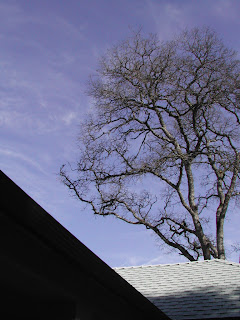
In walking the neighborhood I noticed that some of the oak trees have lost their leaves and some have not. The blue oak is a drought-deciduous tree, meaning that it looses its leaves by late summer when there are drought conditions. The trees that still have their leaves are invariably in the middle of rich green well watered lawns. Remember the comment from the Landscape Design Class instructors (top of this blog entry), I guess we will know for sure if we are over watering by the blueish-green foliage next Christmas.
The following photograph illustrates how the neighborhood got its name, The Woodlands; the name of the development project in which we live. Turns out it is both accurate and apropos of the landscape. Note that the tree that lives on the green lawn has it's leaves.
I believe we have a blue oak (Quercus douglasii) based on the key to the tree oaks of California published in the afore mentioned book.
Here is a satellite photo of the area taken before the road was cut and the trees cleared.

Blue Oak Habitat
The habitat traits of the blue oak that are applicable to Auburn are; found in the foothills bordering hot interior valleys, annual rain fall between 15-35 inches, soil not well developed, and below 3,500 feet in elevation.Blue Oak Distribution
The blue oak is found only in California where it is widely distribute to 39 of the 58 counties. It is the landmark species of the foothills in the Sierra Nevada range. Disjunct populations occur on the Sutter Buttes in the middle of the Sacramento Valley.
Field Trips
- US Davis Arburitium (oak tree collection)
- Indian Grinding Rock State Historical Park (Miwok Indians) acorn usage
Associated Hardwoods and Conifers
- madrone
- bay laurel
- incense cedar
- Douglas fir
- ponderosa pine
- gray pine
Glossary
- Overstory―The uppermost layer of foliage and branches in a piece of vegetation; the highest canopy.
- Savanna―A grassland with scattered trees as a sparse overstory. The tree canopies do not cover more than 30% of the ground surface.
- Snags―Trees that are dead but standing.
- Woodland―An open, tree-dominated vegetation with more tree cover than a savanna but less than a forest. Tree canopies contribute more than 30% cover but seldom overlap.
First Flower of Spring 2007
Thursday, February 15, 2007
Directions to Loughhaven in Auburn
From Sacramento heading East on 80
- Exit Maple St., "Auburn, Old Town"
- Head straight up the the hill, exit freeway but don't turn
- Continue on Maple past the Court House (on right), do not turn
- Maple becomes Auburn-Folsom Rd. at the light, do not turn
- Auburn-Folsom Road will cross High Street, do not turn
- Right turn on Racetrack St., the first light past High Street
- Right on Timberline Ln.
- Left of High St.
- 1665 is on the left, just past Clark St.
From Reno, North Lake Tahoe, heading West on 80
- Exit Maple St., "Auburn, Old Town" (first exit past 49)
- Clover leaf around back over the freeway
- Left on Maple, you'll go past the Court House (on right)
- Maple becomes Auburn-Folsom Rd. at the light, do not turn
- Auburn-Folsom Road will cross High Street, do not turn
- Right turn on Racetrack St., the first light past High Street
- Right on Timberline Ln.
- Left of High St.
- 1665 is on the left, just past Clark St.
Satellite Photographs of Loughhaven
Here are the satellite photographs (click on a picture to see the full size image) of Loughhaven retrieved from the web. North is at the top of the picture. This picture was taken before construction was begun on our house.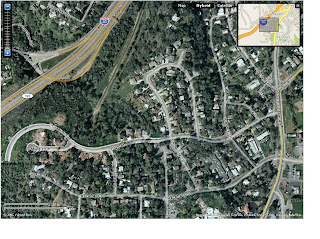 This picture was taken after the place was built. Interestingly, the house did not appear on Yahoo maps until we actually moved in, the week before the satellite showed a tree covered lot.
This picture was taken after the place was built. Interestingly, the house did not appear on Yahoo maps until we actually moved in, the week before the satellite showed a tree covered lot.
 Same shot with the streets labeled.
Same shot with the streets labeled.
 Finally, a map of the same area. Note that the Interstate 80 freeway exits are show.
Finally, a map of the same area. Note that the Interstate 80 freeway exits are show.

Microsoft Virtual World has satellite photos from before the land was cleared.

Tuesday, February 13, 2007
Moby Dick in 1712
 Moby Dick 6 Audio CDs
Moby Dick 6 Audio CDs
Never had to read Mody Dick in school, Andrew had to but not me. When I saw the book tape at the library the guilty school boy said I should "read" the book now that I am old enough to actually understand the wisdom of this "great American novel".
I found it hard to listen to for a couple of reasons. First, the recording's sound level was to low to hear over the mini road noise (when driving > 60 MPH). Second, the language of the book is foreign to my ear and required more effort then this old brain wanted to exert. Dutifully I listed to the whole thing thinking that I would be able to say, Oh why yes, I've read Melville. How could anyone expect young people to be able to grasp the depth and breath of such a work? Duh! Did I missed something or something, shouldn't great art transcend the limitation of time? When I listened to Beowolf last year it's strength withstood translation. I don't get the big white deal.
***BULLETIN*** the abridged book may be somewhat less than the whole. [A third of the whole.]
 1712 Overture & Other Musical Assaults Music CD
1712 Overture & Other Musical Assaults Music CD
From time to time the reading of Melville reminded me of a piece that Prof. Peter Schickele, assistant substitute night school instructor at the U of SND at H, performs on the his 1712 Overture recording. The specific composition that sounds like Moby Dick was written by Prof. Schickele to commemorate J.S. Bach's 300th birthday, DOB March 21, 1685; Bach Portrait for speaker & orchestra. Hey, you think Schickele is comparing the great white composer to the great white whale that suck all in his wake down it the foamy vortex of his greatness?
Moby Dick [UNABRIDGED] 19 Audio CDs
 In doing the research for this blog entry I came across the unabridged audio CD of Moby Dick (135 frikkin chapters + epilogue) read by the same fine performer, William Hootkins. This 19 disk collection retails for $127. My guess is that the orchestration heard on the abridged version [above] was originally commissioned for this complete rendering. I don't want to tackle the unabridged tape at this time. Maybe I'll read the Cliffs Notes® first. :)
In doing the research for this blog entry I came across the unabridged audio CD of Moby Dick (135 frikkin chapters + epilogue) read by the same fine performer, William Hootkins. This 19 disk collection retails for $127. My guess is that the orchestration heard on the abridged version [above] was originally commissioned for this complete rendering. I don't want to tackle the unabridged tape at this time. Maybe I'll read the Cliffs Notes® first. :)

Monday, February 12, 2007
Landscape Lighting Ideas
With all the stucco on surfaces a dramatic washing would be bold and distinctive. Perhaps something up the side of the house to catch the eye of people driving up to the house.

 The builder stretches the canvas on the frame. We have to complete the design and realization of our home. Adding elements like shutters or wall sculpture should not only fit into the style during the day but their accent at night should also be considered.
The builder stretches the canvas on the frame. We have to complete the design and realization of our home. Adding elements like shutters or wall sculpture should not only fit into the style during the day but their accent at night should also be considered.
 Japanese maple in the winter is more than a bare tree. In the summer it is beautiful with its delicate red leaves (momiji). In the winter when folks come over for session the same maple will be clearly visible in the dark thanks to the lighting.
Japanese maple in the winter is more than a bare tree. In the summer it is beautiful with its delicate red leaves (momiji). In the winter when folks come over for session the same maple will be clearly visible in the dark thanks to the lighting.
 Lighting can turn the dark looming tree into a focal point outside the bedroom window.
Lighting can turn the dark looming tree into a focal point outside the bedroom window.
 Although we will not have a rock house, this kind of even wash could look pretty cool on the stone walls. I am thinking in the running wall in back primarily but we'll have to think about doing it in the front yard.
Although we will not have a rock house, this kind of even wash could look pretty cool on the stone walls. I am thinking in the running wall in back primarily but we'll have to think about doing it in the front yard.

Sunday, February 11, 2007
Far Away, Dangerous Dance
X:211 T:Far Away T:Up Down And Around T:Marie's T:Wild Asparagus M:3/4 L:1/8 R:waltz K:Bmin z4 FA |B2 BA Bd |cA F2 FA |B2 BA B3/4c/e3/4 | c4 dc |B2 BA B3/4c/d3/4 |cB A2 de |fe dc BA | B3 A FA |B2 BA Bd |cA F2 FA |B2 BA B3/4c/e3/4 | c4 dc |B2 BA B3/4c/d3/4 |cB A2 de |fe dc BA | B3 c de |f2 fe f3/4g/a3/4 |ec A2 de |f2 fe f3/4g/a3/4 | e4 de |fd Be cA |dB Gd BG |F2 B2 BA | B3 c de |f2 fe f3/4g/a3/4 |ec A2 de |f2 fe f3/4g/a3/4 | e4 de |fd Be cA |dB Gd BG |F2 B2 BA | B3 A FA |]Pete Grant sang Dangerous Dance, it is becoming a favorite. Perhaps I'll learn it to sing at the Starry Plough.
On bodhrán, I played a nice new rhythm with Tobin's Favorite (jig) and The Road To Kilfinora. Accent the bold counts.
1 & 2 & 1 & 2 & 1 & 2 & 1 & 2 &
How to play piano without practicing
Good afternoon, would you like to enjoy your lunch here with us today? No, then perhaps we could prepare something scrumptious for you to take with you.It really bugged me that the kid at this place barked Here2go! whenever anyone walk in the door.
My thoughts about the piano class follow.
- Actual class title was Instant Piano for Hopelessly Busy People. It is based on the work of Robert Laughlin, Learning Pop Piano Fast and Fun.
- It is awkward to play C major then G major. I learned about chord inversions, that can make transitions much more natural for the hands.
- Chord inversions work well when you need a 7th. It is OK to drop the fifth.
- Just the 7 and 8 are all you need to define a major 7th chord.
- G7 resolves to C.
- D7 resolves to G.
- This class was not what I expected.
- I was expecting to learn how to play piano by ear, to be freed from the chains of classical training into a heart opening experience of playing that wonderful music that I hear in my soul.
- This class is for people who want to start learning piano and are motivated but for some reason have mental blocks to the classic approach generally taught to kids.
- God how I appreciate Chris Caswell and his Guerrilla Music Theory course.
- Go back to W.A. Mathieu's book Harmonic Experience and study!

- Play the chords with the left hand in the octave below middle C. Any lower and the ear will not be able to make it out very well, it gets muddy.
- Sheet music only includes the chord changes. So if a measure does not have a chord notation above the downbeat then it is implied that one plays the chord from the previous measure.
- The top of her list of recommended books was my favorite piano book, Hanon, The Virtuoso Pianist. Boy do I love to play the Hanon etudes.
- For a modern sound add a 6th to the chord.
- For the sound of chimes play a parallel 6.
- The diminished 7 chord is four notes each 1.5 steps from its neighbor. There are only three of these dim7 chords. This is what you hear when a villains enters the room or someone is falling down stairs.
- Music box sound comes from playing the notes of a chord 1-5-3-5 repeatedly.
- Cowboy sound is 1-5-6-5 repeatedly.
- Blues 12 bar pattern (primary and variation)
C C C C F F C C G G C C
C C C C F F C C G F C C
Landscape Design Class Notes
Live with the land!
- Live with the land. Go through the seasons with the land so you will know all you have to contend with. Go for walks in the neighborhood at all times of day in all seasons to get a feel for the microclimate.
- FIRST―Overall Plan, plan it all out first. The implementation may be staged but you better know the final requirements before you start bringing in the bulldozers. Budget 10% of the cost of the property for landscaping.
- Collect a lot of information. Collect more info and ideas; what to you love, what do you like, what do you hate. Sources of information include:
- magazines
- books
- driving around looking at landscape
- take photographs; what to you love, what do you like, what do you hate
- Google landscape keywords
- create a wish list (don't limit yourself by resources or time)
- home shows
- Take pictures of plants in the store, especially specialty plants that are rarely available (to order later).
- Do a soil analysis early in the planning process.
- Style vs Theme
- The front yard reviews the home's interior. The interior previews the patio and back yard. Keep this in mind when thinking about style and theme.
- Style—English, Mediterranean (South France, Turkish, Morocco, etc.), Oriental, Zen Garden, Space Age, High Tech, etc.
- Theme—rusted iron, antique, rocks of interest, Disneyland, recycled, eco friendly, indigenous plants, coral reef, etc.
- Hardscape first; all the non-plant stuff, plants come and go but hardscape stays forever.
- Determin the shapes and locations before getting into the specific materials.
- Water Feature
- conseal noise
- focal point
- fountain, pond, waterfall
- pleasent sounds
- run sleeves for potential water features under pateo
- self filling is very important
- Walkway is 4 feet wide, a pathway is 2 feet wide
- Vegatable garden should be raised (why?). Consider rocks or cinder blocks instead of redwood.
- Walls―why do you want it, it is for sitting also? If the height is 3 feet or more you will need a building permit and engineering drawings.
- Moss rock bolders, (what are they?) inexpensive but sometimes overdone.
- What about tool storage?
- Sitting
- The First thing you see?
- To many forcal points will not be restfull
- Pottary sucks up water so you need to water daily.
- Lighting
- Low voltage, not solar
- defused glass, reduce glare
- sconces illuminate without getting in your eyes
- well lights or up lights
- high quality equipment, Home Depot crap will need replacing is a couple of years
- plan early, install after plants
- low voltage wires run under mulch
- Find an arborist to look at the oak trees. Water will kill these oaks.
- Soil Browkers―look at the load before it is dumped, request "weed free"
- Site Survey
- Talk to neighbors, what are they planning, what will they be ripping down, what about the big trees that span both properties
- puddling and/or streams during wet season
- Take pictures, inside house looking out, outside from places you'll be, different angles, built in focal points
- microclimates
- Guest entry; how will visitors enter the house, handicap entry
- Define areas of use
- needs
- wants
- stuck with: train tracks, air conditioner pad, leach field, pool
- Draw Plans
- Start with properly lines and house. Make copies to work with.
- Scale: 1 inch = 8 feet
- Underground power, telephone, water, waste, drains, sleeves
- Irrigation plan with down spouts
- House, hose bibs, windows, views
- After drawing existing us that to draw various plans
- Drainage
- Walk the land in the rain
- Clay holds water
- Take pictures when it is wet, see the standing water and flowing streams
- French drain
- Sump pump
- Soil tests, plan to ammend soil
- Hydro zoning―each area will have different water requirements
Japanese Style
- red maple (200 variaties)
- mugmugo pine
- juniper
- cluming/non-running bambo
- wheeping cherry
- manzaneta, pruned to expose limbs
- azalea
- hardscape
- pond
- waterfall
- tsukubai
- shi-shi-o-doshi
- stone lanterns
- sand garden
- coral bark maple
Website References
Garlic Bread
We prepared the bread spread Friday evening after work and picked up some fresh french bread at the super market bakery early Saturday morning.
Mix all the ingredients save the bread together in a Tupperware bowl.
- 1 stick of unsalted butter, room temperature
- 1/2 head of garlic, break about into cloves skin on, roast on stove top med-high for 10 minutes, cool and remove skin, push through a garlic press
- 1/3 cup of grated Parmesan cheese (more is goood)
- Salt
- Fresh black pepper
- Italian herbs; oregano, thyme, basil, etc. (optional)
- Preheat the oven to 500° F.
- Cut the loaf in half on the coronal plane.
- Divide the spread mixture in half.
- Smear half the butter spread onto each cut half of bread.
- Bake buttered side up for 6-10 minutes. Remove when edges are browned.
- Cut into about 12 pieces.
- Eat it while it is hot.
Monday, February 5, 2007
Empire Mine Walk
 There is a walking trails map available at the visitors center but Earin and Dick picked out one not in the brochure. It is a new trail that leads gently down hill from the smaller parking lot across the street from the park buildings. The trail head is at about 11 o'clock when you cross the street. It goes to the west, gently down hill towards Grass Valley, past large piles of stone pushed out of the mines. As you can see below it has become overgrown.
There is a walking trails map available at the visitors center but Earin and Dick picked out one not in the brochure. It is a new trail that leads gently down hill from the smaller parking lot across the street from the park buildings. The trail head is at about 11 o'clock when you cross the street. It goes to the west, gently down hill towards Grass Valley, past large piles of stone pushed out of the mines. As you can see below it has become overgrown.
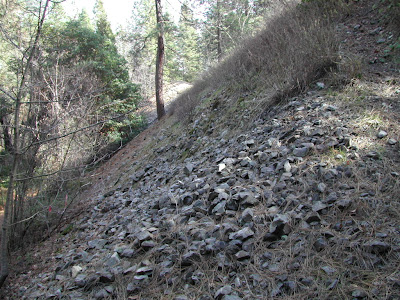
 The hike took about an hour and is suitable for people not use to walking much.
Earin and I potted a butterfly with black/dark wings and a bright yellow trailing edge, about a 3 inch wingspan. If she looks up the name I'll update this entry.
The hike took about an hour and is suitable for people not use to walking much.
Earin and I potted a butterfly with black/dark wings and a bright yellow trailing edge, about a 3 inch wingspan. If she looks up the name I'll update this entry.
After the walk we studies the model of the mine shaft network and browsed the minerals displayed in the gift show.
We will go back and take the tour when we have out of town guests.
After the park we went to Earin and Dick's to watch the Super Bowl. Great game with a very exiting first quarter.
The chili was good. Normally I make it a little to spicy hot but I kept it toned down since I didn't know Dick's heat index.
In addition to the recipe I blogged yesterday, I added a cup of water when it started to simmer. Simmered for four hours stirring every 20 minutes, it never did stick to the bottom of the pan. I let the chili sit on top of the stove over night to cook in its own heat. In the morning it was starting to look and taste like chili but it wasn't done yet. I turned the heat back on low for 3 more hours to complete the breakdown of the beef chunks.
Saturday, February 3, 2007
A Super Bowl of Chili
 Sharon and I are going for a hike on Super Bowl Sunday with Dick and Earin. Afterward we will be getting lunch and then going to their place to watch the game.
Sharon and I are going for a hike on Super Bowl Sunday with Dick and Earin. Afterward we will be getting lunch and then going to their place to watch the game.
I am making my chili today so that it will have a chance to flavorize before the game. I start with America's Test Kitchen (why I love ATK) recipe for "Simple Beef Chili with Kidney Bean" (see below) and modify it for my tastes.
- Substitute a can of chick peas for a can of kidney beans. Then ad a can of black beans. All the beans should be washed until the can drains clean.
- Add a pound of Andouille sausage or hot links, cut into ¼ in diagonal cross sections. Brown the links before adding it to the pot. Eat the end pieces while they are hot and crispy.
- Add 2 pounds of extra firm tofu, ½ in cubes.
- I use a complete bottle of chili powder.
- Heavy on the spices since we're adding another 4 or 5 pounds of protein.
- An additional pound of chuck roast (shoulder), cut into chunks and browned. If you use these chunks of meat then it needs to simmer for a couple of hours until the chunks fall apart when pulled by a fork.
- Start off the meat preparation by cooking 8 strips of bacon on med-hi for about 10 minutes. Set the bacon bits aside and save the fat for cooking the rest of the meat and the vegetables.
 A dutch oven would be great for preparing all the meat but this recipe is to large it fit everything into a 8 quart pot. Assemble in a big old soup pot and simmer, don't scrape the burnt chili off the bottom of the pot, just let it stick.
A dutch oven would be great for preparing all the meat but this recipe is to large it fit everything into a 8 quart pot. Assemble in a big old soup pot and simmer, don't scrape the burnt chili off the bottom of the pot, just let it stick.
Quick Tip―spray the plastic storage containers with PAM to keep the chili from staining the plastic.
Below is America's Test Kitchen recipe from their TV show's website.

Simple Beef Chili with Kidney Beans
Good choices for condiments include diced fresh tomatoes, diced avocado, sliced scallions, chopped red onion, chopped cilantro leaves, sour cream, and shredded Monterey Jack or cheddar cheese. If you are a fan of spicy food, consider using a little more of the red pepper flakes or cayenne--or both. The flavor of the chili improves with age; if possible, make it a day or up to five days in advance and reheat before serving. Leftovers can be frozen for up to a month.
Makes about 3 quarts, serving 8 to 10
| 2 | tablespoons vegetable oil or corn oil |
| 2 | medium onions , chopped fine (about 2 cups) |
| 1 | red bell pepper , cut into 1/2-inch cubes |
| 6 | medium cloves garlic , minced or pressed through garlic press (about 2 tablespoons) |
| 1/4 | cup chili powder |
| 1 | tablespoon ground cumin |
| 2 | teaspoons ground coriander |
| 1 | teaspoon red pepper flakes |
| 1 | teaspoon dried oregano |
| 1/2 | teaspoon cayenne pepper |
| 2 | pounds 85% lean ground beef |
| 2 cans (16 ounces each) kidney beans (dark), drained and rinsed | |
| 1 (28-ounce) can diced tomatoes , with juice | |
| 1 can (28 ounces) tomato puree | |
| table salt | |
| 2 | limes , cut into wedges |
Instructions
- Heat oil in large heavy-bottomed nonreactive Dutch oven over medium heat until shimmering but not smoking, 3 to 4 minutes. Add onions, bell pepper, garlic, chili powder, cumin, coriander, pepper flakes, oregano, and cayenne; cook, stirring occasionally, until vegetables are softened and beginning to brown, about 10 minutes. Increase heat to medium-high and add half the beef; cook, breaking up pieces with wooden spoon, until no longer pink and just beginning to brown, 3 to 4 minutes. Add remaining beef and cook, breaking up pieces with wooden spoon, until no longer pink, 3 to 4 minutes.
- Add beans, tomatoes, tomato puree, and 1/2 teaspoon salt; bring to boil, then reduce heat to low and simmer, covered, stirring occasionally, for 1 hour. Remove cover and continue to simmer 1 hour longer, stirring occasionally (if chili begins to stick to bottom of pot, stir in 1/2 cup water and continue to simmer), until beef is tender and chili is dark, rich, and slightly thickened. Adjust seasoning with additional salt. Serve with lime wedges and condiments if desired.



